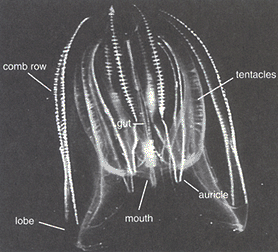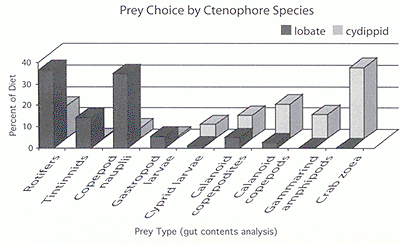
|
Archives:
Fall 1999 Table
of Contents Sometimes it’s important to study the little things to get the big picture. Just ask Rebecca Rapoza, a doctoral student in the WHOI/MIT Joint Program in biological oceanography. Rapoza studies ctenophores, specifically their diet and feeding behaviors.
Ctenophores (pronounced teen-a-fours) are gelatinous marine invertebrates: primitive animals with simple body forms. Often called comb jellies, they are completely unrelated to jellyfish, though they are somewhat similar in appearance. Ctenophores are located throughout the world’s oceans. They are very effective predators, consuming both mesozooplankton (200 µ to 2 mm) and microzooplankton (20—200 µ). Rapoza’s
work, supported by WHOI Sea Grant and The Seaver Institute, focuses
primarily on ctenophores in the Order Lobata, although a portion
of her thesis compares the diet and morphology of Lobata to another
Order of Ctenophora, Cydippida. Cydippids have two elongate tentacles that are used to net prey as the animal sits motionless. This ensnarement technique allows the cydippids to capture highly mobile prey. Lobates, as their name implies, have two large lobes that surround a body bearing rows of modest-sized tentacles (see photo). Using four flap-like ciliated auricles, they draw water into the space between the lobes (or ‘inter-lobe space’). This flow, known as the feeding current, enables the animal to capture low-speed or weak swimmers by trapping them on the tentacles. Larger prey typically swim into the inter-lobe space and are caught on the sticky inner surface of the lobes. The two methods of prey-capture enable lobates to effectively prey on both small, passive prey and large, active prey. According to Rapoza and her colleagues, that ability to also feed on microzooplankton was probably a driving force behind the evolution of lobates from a cydippid ancestor. Because of their differing feeding strategies, lobates and cydippids can co-exist and flourish. "For a long time," says Rapoza, "it was assumed that lobates were simple, non-selective feeders: they would consume indiscriminately–whatever they came upon." Recent observations by Rapoza and others seem to disprove that long-held notion. Rapoza has observed–through videotaped footage of captive animals–that the behavioral repertoire of these stealth predators is surprisingly complex. "For example," explains Rapoza, "not only do the auricles create the feeding current, they enable lobates to sense approaching prey, reach out, and immobilize them against the food groove that carries the prey to the mouth." How does the ctenophore create this quiet environment between the lobes, where prey do not sense approaching doom? To answer this question, Rapoza used a particle image velocimeter (PIV) to study flow fields immediately surrounding the animals. The PIV uses a two-dimensional light sheet to illuminate particles in the water directly surrounding the animal. By tracking the movement of these particles, characteristics of flow that are important to prey capture can be mapped and understood. The use of tools such as the PIV, and light and electron microscopy, have allowed Rapoza and her collaborators, John Costello of Providence College and Tony Moss of Auburn University, to gain insight into the functional morphology of lobates, as well as prey-capture techniques. While the feeding and prey-capture dynamics of lobate ctenophores may not at first seem important to overall food chain dynamics, consider that their main food source happens to be the food of choice for the larvae of cod and other commercially important fishes. By learning more about the mechanisms by which lobates select and catch prey, Rapoza and her colleagues, including her advisor, Larry Madin, a senior scientist at WHOI, hope to aid scientists in predicting what kinds of prey will be vulnerable. In the Black Sea, for example, the lobate ctenophore Mnemiopsis leidyi was introduced through ballast water discharge in 1982. Its predation on zooplankton and larval fish caused severe damage to commercially important fish stocks for several years. By
studying predator-prey interactions, Rapoza is contributing to the
overall understanding of how ecosystems function. Whether scientists
focus on broad scale distribution of organisms or, as in Rapoza’s
case, microscale processes of individual organisms, it is the integration
of all relevant information that helps us make better predictions
of how our ocean environment is changing. By adding her research
pieces to the puzzle, Rapoza has gained an appreciation for looking
closely at the little things to gain insight into the big picture.
|

